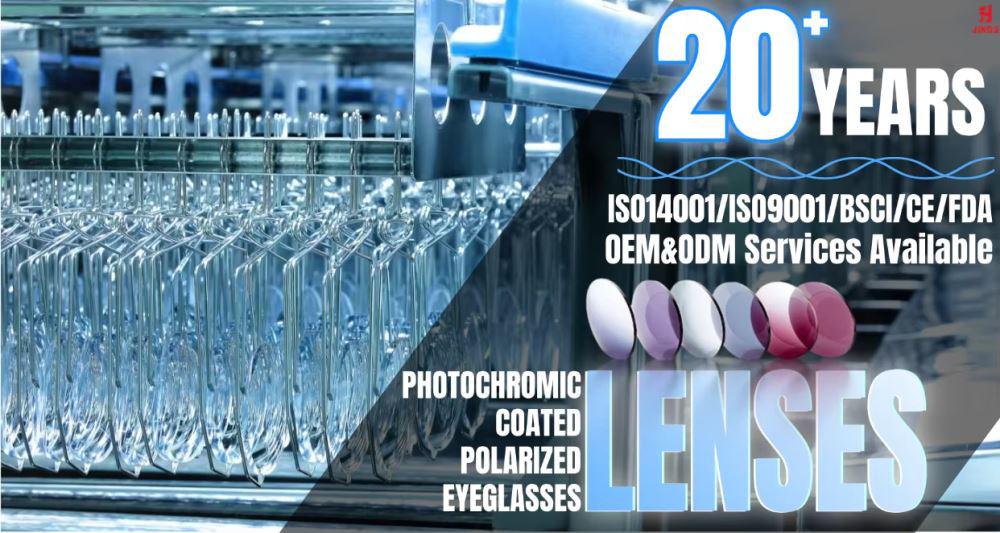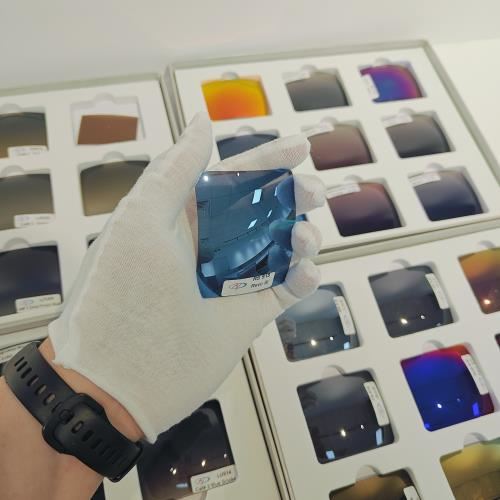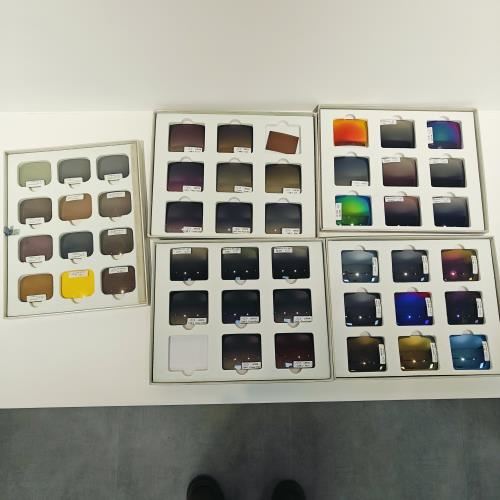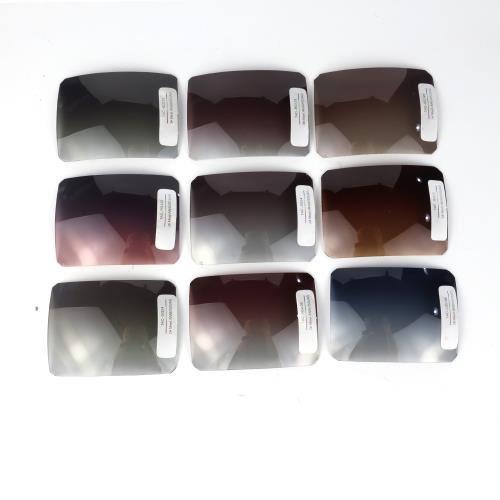
1. Resin lenses: a type of lens made of organic materials
CR-39, scientific name Dially Glycol Carbonates, is the most widely used material for producing ordinary resin lenses.
It was discovered by chemists at Columbia Corporation in the United States in the 1940s. It is the 39th material in a series of polymers developed by the US Air Force, so it is called CR-39 (Columbia Resin No. 39).
CR-39 Allyl Diethylene Glycol Carbonate
Properties: polymer material
Scientific name: Dially Glycol Carbonates
CR-39 was used to produce eye correction lenses from 1955 to 1960. It is the first generation of ultra-light, impact-resistant resin lenses. As a thermosetting material, CR-39 has a liquid monomer that polymerizes and solidifies under heating and the addition of a catalyst. Polymerization is a chemical reaction, that is, a new polymer molecule composed of several monomers with the same molecular structure has different lengths and properties. As an optical lens, the parameters of CR-39 material properties are very suitable: refractive index of 1.5 (close to ordinary glass lenses), specific gravity of 1.32 (almost half of glass), Abbe number of 58~59 (only a little dispersion), impact resistance, high light transmittance, can be dyed and coated.
Its main disadvantage is that it is not as wear-resistant as glass and needs to be coated with anti-wear film. Resin lenses can use the pattern pressing method to process the curvature of the lens surface, so it is very suitable for the production of aspherical lenses.
◆Light transmittance
CR39 resin lens: 92%
Glass lens: 91%
◆Specific gravity
CR39 resin lens: 1.32g/cm3
Glass lens: 2.54g/cm3
◆Impact resistance test (16g steel ball 1.27m free fall)
CR39 resin lens: not broken
Glass lens: broken
◆Broken condition
CR39 resin lens: large pieces. No sharp angles
Glass lens: fine pieces. Sharp
◆Blocking ultraviolet rays
CR39 resin lens: 390nm
Glass lens: 290-300nm
◆Refractive index
CR39 resin lens: 1.502
Glass lens: 1.523
◆Thickness
CR39 resin lens: thicker
Glass lens: thinner
◆Abrasion resistance of glass is better than that of resin
◆Fog tendency of resin is better than that of glass. Reduced by 60-75%
◆Dyeing CR39 resin lens: easy to color Glass lenses: not easy to tint
Advantages: light weight, more comfortable to wear, strong impact resistance, not easy to break and safer, good light transmittance;
Disadvantages: surface wear resistance, chemical corrosion resistance is worse than glass, the surface is easy to scratch; water absorption is greater than glass, these disadvantages can be improved by coating method; fatal disadvantages are high thermal expansion coefficient, poor thermal conductivity, low softening temperature, easy deformation and affecting optical performance;
The more common lens materials on the market are of various types and complete functions, suitable for various learning and work needs of young and middle-aged people;
2. PC lenses: Also known as space lenses, they are impact-resistant and lightweight.
Advantages: Strong toughness and not easy to break, can effectively prevent lens breakage during intense exercise, light weight, and UV protection;
Disadvantages: Difficult processing, less than ideal dispersion control, and high price;
It is recommended to choose PC materials for children's glasses. Compared with other lenses, PC materials are light in weight, have better impact resistance, and are safer. Not only that, they can also protect glasses from UV rays;
PC lenses have extremely strong toughness and are not easy to break, so they become safe lenses. They weigh only 2 grams per cubic centimeter and are currently the lightest material used for lenses.
3. Glass lenses: The main raw material is optical glass. Due to the addition of different elements to the lens material, the refractive index changes, and it can be divided into white lenses, red lenses, etc.
Advantages: high surface hardness, scratch resistance, good optical performance, good light transmittance and mechanical and chemical performance, and high refractive index;
Disadvantages: large mass, affecting wearing comfort, and fragile;
Glass lenses are bulky and have a low safety factor, but they are scratch-resistant and have a long service life. They are suitable for elderly people with less exercise and low-degree presbyopia;
4. Polarized lenses: lenses that only allow light of a certain polarization direction to pass through. Due to its filtering effect, it is not dazzling when you wear it, and it is especially suitable for outdoor sports.
Advantages: It can filter out many irregular light interferences to avoid dazzling and glaring phenomena;
Disadvantages: If the arc of the lens itself cannot be in the optical standard refractive state, the polarization effect will be weakened, affecting the authenticity of the image, and the durability is poor;
Suitable for outdoor activities such as driving and fishing;
5. AC lens: also called acrylic lens,
Advantages: extremely high perspective, good anti-fog, higher hardness and more wear-resistant than PC sheet;
Disadvantages: AC and PC are both resin lenses, heavier, and easier to crack than PC sheet;
Mainly used for samples, lining boards, and panels;
6. Nylon lenses: The material is transparent polyamide, which is a new variety of polyamide. Due to its physical characteristics, many luxury brands of sunglasses are made of nylon and used in special industries as professional protective equipment;
Advantages: Very high elasticity, can be used to make glasses of different shapes, with excellent optical quality and strong impact resistance;
Disadvantages: Poor wear resistance compared to glass, and high production cost;
Generally used in sports brands and high-quality big-name sunglasses. When nylon lenses were invented, they were used as eyeglass protectors with professional protective functions;




7. Photochromic lenses: The principle is "photochromic" [photochromic lenses darken in color outdoors, reaching a state similar to sunglasses; returning to colorless and transparent characteristics indoors]
Divided into: base change and film change
Base change: The color change is in the lens substrate (which can be understood as the lens material itself). The substrate color change is the chemical reaction color change under light after silver halide and copper oxide are added to the substrate.
When the substrate changes color, the entire lens will change color. The thicker the lens, the darker the color change.
Advantages: high cost performance, high temperature resistance, not easy to lose the color change effect due to high temperature, long color change time;
Disadvantages: uneven color change, lenses are prone to "panda eyes", you can choose a lens with a lower refractive index and slow color change and fading speed.
Film change: The color change is on the lens film layer. A layer of "intelligent color change factor" is evenly applied on the surface of the lens. After the color change, the depth of the color will not be different due to different lens thicknesses.
Advantages: There are no restrictions on lens power, material, thickness, etc., and the color fades quickly and evenly; it can also produce progressive lenses, blue light protection lenses, etc.;
Disadvantages: The color change time is short, high temperature is prone to non-color change, and the film layer is prone to scratches;
Generally speaking; the ultraviolet rays are stronger in sunny weather: the photochromic reaction is more intense, and the depth of the lens after color change is generally deeper;
The ultraviolet rays are weaker on cloudy days, the illumination is not strong, and the color of the lens will be lighter;
Copyright @ 2025 Xiamen Jings Eyewear Co., Ltd. All Rights Reserved.
 Network Supported
Network Supported